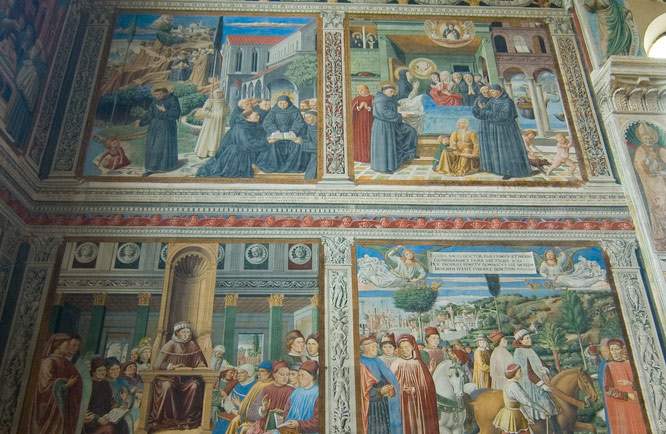Restoration work on frescoes by Benozzo Gozzoli (Florence, c. 1420 - Pistoia, 1497) in the church of Sant’Agostino in San Gimignano (Siena) will begin tomorrow, Monday, Sept. 23. In fact, the situation of the paintings, a cycle of frescoes dedicated to the life of St. Augustine and dating from 1464-1465, was critical: in the spring, restorer Daniele Rossi had reported that some cracks in the scenes of the precious 15th-century frescoes would risk causing irreparable damage over time. These were, in short, damage to the structure, due to ground movement, the repair of which could no longer be postponed. This had resulted in an appeal by the mayor of the Tuscan town to the Superintendence of Siena, Arezzo and Grosseto (which, in any case, has been monitoring the frescoes and the whole church for years): an appeal that was promptly taken up, and with an initial allocation of 200,000 euros (out of a total planned expenditure of 510,000 euros) the work can now begin.
The interventions will start with a campaign of geotechnical investigations and a photographic campaign (which will aim to study, on the one hand, the ground on which the church rests, and on the other hand, the problems suffered by the frescoes), which will be followed by the securing of the structure, the consolidation of the walls, the restoration of the frescoes and, finally, the improvement of the apse of the church in an anti-seismic function. Felicia Rotundo of the Superintendence of Siena, Arezzo and Grosseto has been entrusted with the direction of the work, while Daniele Rossi will be in charge of securing the frescoes. The securing operations will take about three months.
“This is considered one of Benozzo Gozzoli’s most important fresco cycles,” said Siena Superintendent Andrea Pessina, “and we know well the role this author played in the history of 15th-century art.”
“What begins today,” stressed the mayor of San Gimignano, Andrea Marrucci, “is the result of a team effort that is the fruit of the union of intent between the ministry, superintendency, and municipality but also with individual citizens, professionals and associations that together with us have raised the cry of alarm for these frescoes.” Restorer Daniele Rossi further explained, “We will stop the injuries that the frescoes have in order to secure the painting and to let the structural and study work continue afterwards; we will suture the wounds of the frescoes through localized injections and we count on dismantling the site for the Christmas holidays.”
Benozzo Gozzoli created the frescoes of St. Augustine after he left Florence, due to a plague, in 1463: the artist was coming from what is perhaps his most famous endeavor (the Chapel of the Magi in the Medici Palace in Florence) and obtained the commission for the church of San Gimignano from Fra’ Domenico Strambi, an Augustinian monk who held the patronage of the church’s main chapel, the one that would later be decorated by the Florentine painter. To execute his Stories of St. Augustine, Gozzoli followed the suggestions of the patron, a theologian (he had obtained a doctorate from the Sorbonne in Paris) and a connoisseur of Augustinian events and literature, but also the scenes that the Umbrian painter Ottaviano Nelli (Gubbio, 1375 - 1444) had executed in the church of Sant’Agostino in Gubbio (and which Gozzoli, having been in Umbria, probably knew). Benozzo’s cycle consists of a total of sixteen scenes, interweaving the events of St. Augustine with those of his mother, St. Monica, and representing one of the most important and interesting Renaissance cycles in all of Tuscany.
 |
| San Gimignano kicks off restoration of Benozzo Gozzoli's frescoes |
Warning: the translation into English of the original Italian article was created using automatic tools. We undertake to review all articles, but we do not guarantee the total absence of inaccuracies in the translation due to the program. You can find the original by clicking on the ITA button. If you find any mistake,please contact us.